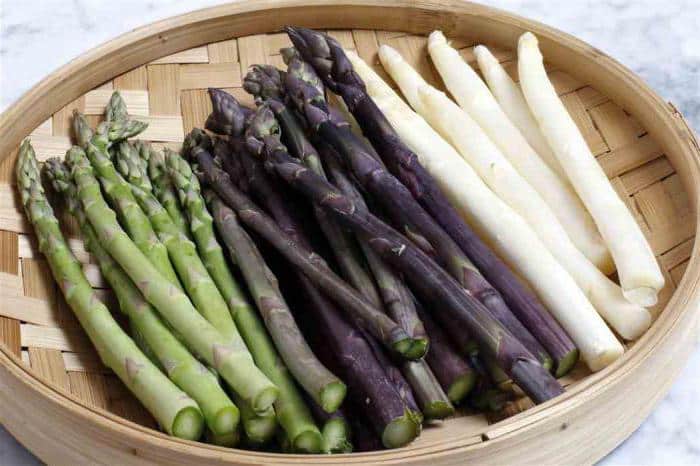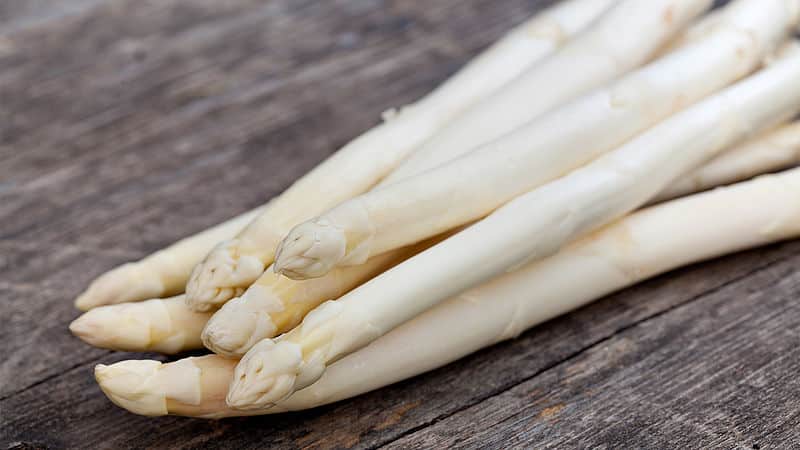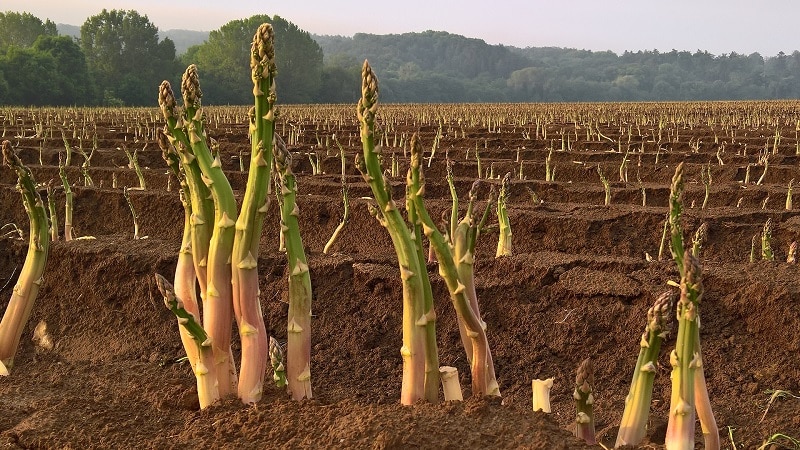Varieties of asparagus: thin-leaved, Argentel and others
Gourmets and lovers of proper nutrition have long paid attention to asparagus, or asparagus. For most, this product is a delicacy, and some have not even heard of it. There are several types of plants that differ in color and taste. The crop is suitable for cultivation in almost all regions: it is unpretentious in care, resistant to low temperatures and drought.
What is asparagus
This is a bushy herbaceous plant that reaches a height of 1.5 m. The foliage resembles the branches of a small-leaved fern, and spear-shaped edible shoots grow vertically from the roots. The fruits are black, inedible berries. Although the crop can grow in almost all countries, its cost does not decrease.
Interesting! Edible shoots appear only in the 4th year of the plant’s life.
There are more than 200 types of asparagus, but not all of them are edible. Most of them serve only a decorative function (for example, thin-leaved asparagus). Some plants are used for medicinal purposes.
The upper parts of young shoots are used in cooking, the ideal length of which is 22 cm.
Plants contain many vitamins and microelements:
- vitamins A, C, E, K, group B;
- magnesium, potassium, copper, selenium, sodium, phosphorus.
There are only 20 kcal per 100 g of vegetable. Regardless of the thickness of the shoots, the taste remains just as pleasant.
They eat asparagus raw. Combine with cheese and olive oil.
Beneficial features

Vegetables bring great benefits to the body:
- removes excess water and harmful substances;
- strengthens the work of the heart;
- reduces blood pressure;
- improves skin condition;
- restores vision;
- strengthens connective tissues and bones;
- reduces the development of varicose veins;
- stabilizes the nervous system;
- helps heal wounds;
- cleanses of parasites;
- fights fungal diseases;
- helps the body fight cirrhosis, atherosclerosis and hepatitis;
- promotes weight loss;
- relieves hangover.
Asparagus useful for lactating and pregnant women, patients with diabetes and men with prostate diseases.
Important! The product should not be used if you are allergic to it, have an exacerbation of gastritis, or have an ulcer in the digestive system.
Overall, the vegetable is healthy for most people. Grow even in Siberia.
What types of asparagus are there?
In addition to varieties, there are several varieties of the plant, which differ in the method of cultivation, taste and use in cooking. Only herbaceous varieties are suitable for eating.
White
The most common type of asparagus is white. Color is achieved by artificially darkening the plant. Rich in potassium and calcium, this variety is often found on shelves and in restaurants.
White asparagus is the most expensive edible species. Its taste is more delicate.
The photo shows white asparagus.

Green
Another common type, which is somewhat cheaper, but not inferior in taste and nutritional qualities to white. Due to the color, the taste of green asparagus is more pronounced.
The vegetable can be stored for up to 90 days. It is rich in phosphorus and vitamin B. After cooking, it remains crispy and juicy.
Purple
The rarest variety has a slightly bitter taste.When cooked, it loses its unusual shade and turns green. Grows in measured amounts of light or in complete darkness.

Red
A subspecies of purple asparagus. Depending on the cultivation conditions, the plant does not fully acquire a purple tint and turns red. The properties remain the same as its counterpart with a bitter taste.
Yellow
Bred by Russian breeders. The earliest species with a yellow upper part and white flesh. According to reviews, the taste is delicate. The variety is just gaining popularity and is therefore rare.
Black
This is the erroneous name for the root crops of Spanish goat. Outwardly, they resemble young asparagus shoots, especially after removing the black skin.
Interesting! Black root contains asparagine and inulin. Good for the cardiovascular system and kidneys.
Marine
Sea asparagus is called salicornia, or European saltwort. It grows on sea coasts and contains a lot of iodine and salt. Average calorie content - 130 kcal per 100 g. The taste is salty, the texture is crispy.

Other
Soy asparagus (yuba, fuju) is a product of Chinese and Japanese cuisines. This is not a vegetable; it is prepared from the foam of soy milk that forms during its cooking. The product is dried and pressed. In Japan, this foam is eaten fresh, often simply dipped in soy sauce.
In Russia, asparagus is often called asparagus beans. This is a completely different plant related to legumes, one of the types of green beans. The product is no less healthy, contains many vitamins, but differs in taste and texture.
Wild asparagus is often found in forests and on mountain slopes. Its long shoots grow up to 1.5 m. After 7–10 days, the young shoots branch and turn into thorns.
Varieties
When growing a crop on a personal plot, pay attention to the timing of growth, harvesting, and resistance to climatic conditions.
Arzhentelskaya
The most frost-resistant variety, which is often grown in Siberia. Asparagus Argentelles ripens early, which is convenient for regions with short summers. The shoots are greenish with pink tips, the flesh is slightly yellow.
Important! The vegetable is contraindicated for children under 2 years of age.
Racemose
This variety is not eaten, but is widely used in oriental medicine. Asparagus racemes contain a large amount of flavonoids, which normalize the functioning of female sex hormones, relieve inflammation, and eliminate spasms. The plant rejuvenates, heals wounds and relieves swelling.
Another name for the variety is shatavari. The roots are used to prepare medicines. In case of overdose, they are dangerous to health.
Glory of Brunswick
The variety ripens late, but produces a large number of shoots, which ensures a bountiful harvest. Vegetables often preserve. The crop is grown on an industrial scale due to its good transportability and high taste.
Interesting! The higher the plant branches above the ground, the more useful its shoots are.
Mary Washington
After 4 years, the sprouts of this variety are tasted. The plant rarely gets sick and tolerates dry summers and frosts well. Mary ripens early and produces juicy and crispy shoots.
snow head
The crown of the shoots is green-cream, which is why the variety got its name. The pulp is creamy, delicate in taste, with the aroma of green peas. The plant is early ripening with strong immunity.
Harvest 6
White asparagus, ripening in the middle of the season, is highly productive (up to 250 g per plant).The culture tolerates sudden changes in temperature, so it is suitable for regions with an unstable climate.
Tsarskaya
Mid-season variety, resistant to frost and drought, with strong immunity to diseases and pests. Royal asparagus is suitable for all regions. The white flesh is tender and fleshy, the taste is delicate. Marketable yield is 2-3 kg/m².
Dutch green
A green variety without an unpleasant aftertaste, with delicate pulp and thin skin. Productivity is high.
How to choose a variety for planting

To grow a crop in your garden, several factors are taken into account:
- region of growth;
- plant type;
- frost resistance;
- harvest time.
Depending on the region
Asparagus feels good in any region, growing both in Africa and Siberia. Most varieties are unpretentious and tolerate severe frosts and drought. At the same time, plants are capable of freezing during unexpected spring frosts, even at -5°C.
Therefore, for regions with sudden spring frosts, varieties that are resistant to temperature changes are more suitable. For the rest, the time of harvest is taken into account - late varieties will not have time to grow during the short summer.
Features of cultivation

All asparagus requires the same care; there are no differences between individual species. The more sunlight hits the garden bed, the greener the sprouts will be.
There are varieties that were originally bred to be white or purple, so their shades vary depending on the species.
Important! For plants, choose hills and hills protected from the wind.
The crop loves fertilizers and responds well to organic matter; it does not tolerate weeds at all. It is propagated by root division, seeds or cuttings.
Growing from seeds is carried out in autumn and in the spring, some plant the crop in a greenhouse.
Asparagus flies and beetles are dangerous pests. Parts of plants damaged by them are removed, landings treated with insecticides.
Conclusion
Asparagus is a healthy, tasty and nutritious plant. The amount of microelements and vitamins, especially silicon, vitamin U, folic acid, exceeds their content in other vegetables. It is not difficult to grow a crop on your own plot; it is enough to follow standard agricultural practices.